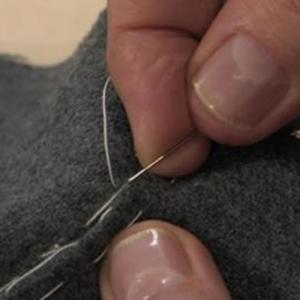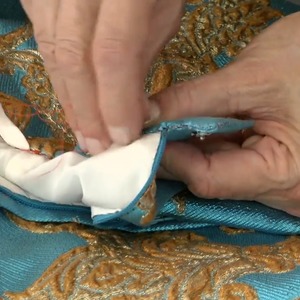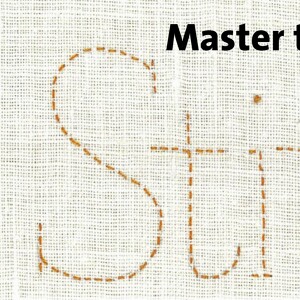How to do a Fell Stitch

Hand stitches are crucial in good finishing; when sewn properly, they are as strong as machinesewn stitches, and you can do them almost as quickly. But many people avoid them and try to always use machines.
A few words on thread before I begin: Any thread longer than the distance from your hand to your elbow will tangle when you work and slow you down. I’ve actually clocked this; it’s faster to re-thread than to fight a long length of thread.
Before they sew, some sewers wax their thread to strengthen it and make it easier to work with. I don’t, but I do iron it to take out any extra twists. When you’re buying thread, beware of bargains. those spools you get ten for a dollar aren’t for fine sewing. Good-quality thread allows you to work faster, and it’s more durable.
You should also always keep a good supply of sharp, high-quality needles. Preferences in lengths and diameters vary; my favorite is a no. 10 milliner’s needle because it’s slightly longer than a regular hand-sewing needle; it feels better in my hand (probably because I’m used to long beading needles). Experiment and find the needle that suits you best. With good thread and your favorite needle, you’re ready to master the fell stitch.
Also called an “appliqué stitch,” a fell (or “felling”) stitch is used to appliqué one layer of fabric (generally a folded or selvage edge) to another. It’s quick, strong, and flexible-the piece sewn on with a fell stitch can move somewhat like a hinge, and that makes it good for installing linings. It is also used to sew lace-either as appliqués or appliqué seams. The fell stitch is seen in millinery work as well as clothing; it…
Start your 14-day FREE trial to access this story.
Start your FREE trial today and get instant access to this article plus access to all Threads Insider content.
Start Your Free TrialAlready an Insider? Log in


































Dear Kenneth,
Don't stop give us more. I love the subjects you demo.
Such beautiful work, and very useful tutorial!
Kenneth,
This is the best and simpliest explanation of the stitch. I love your tips. Keep them coming!
Keep the tips and tutorials coming!!!! They're fantastic!!!
Cool! My grandma and great-grandmother were professional quilt makers for upscale families in Louisville, KY, many years ago. Some of their personal quilts have lovely applique, but I never knew how it was done. Thanks to your illustration, now I do!
This is a very simply way to explain applique stitch.
Love the way you present the stitch. Have use this
stitch many times.
Thanks, Kenneth King! I needed this to apply the lining to my Chanel Jacket! Love your work with Threads!
this was very helpful in sewing a purse lining!
Thank you SO much - just found this - and in the nick of time. Your tutorials are amazing!